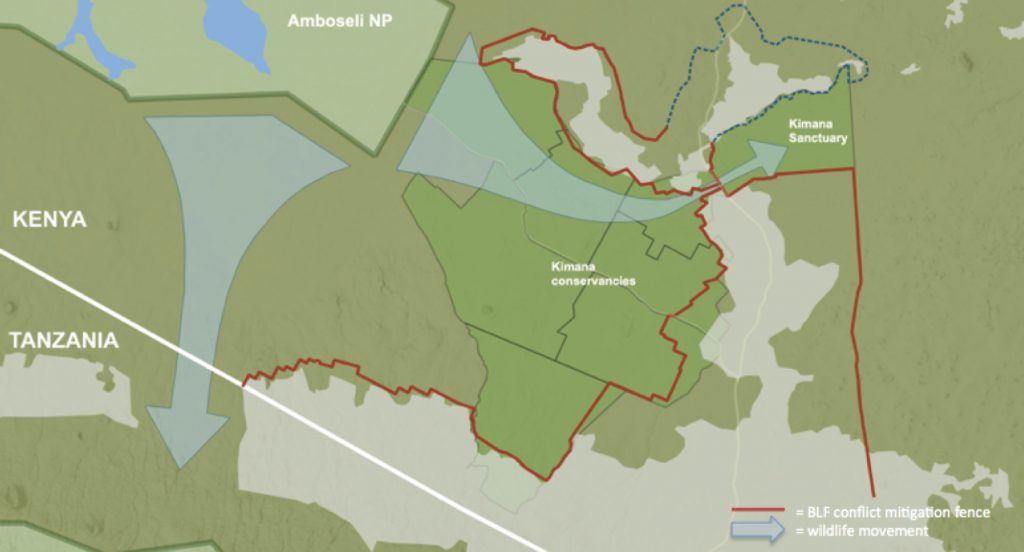Elefant Conservation, Amboseli, Kenya
The rangelands north of Amboseli to the Chyulu Hills and Tsavo West National Parks in the east, and south to Kilimanjaro National Park is a central connection point for migrating wildlife and contains some of the most important habitat left in Africa.
Securing Wildlife Habitat
The land tenure around Amboseli is moving away from a communal ownership model towards small, private holdings. Without careful land-use planning and responsible stewardship, fragmentation on this scale will lead to the implosion of the ecosystem. Big Life has been working with landowners to create plans to protect key wildlife corridors and dispersal areas.
Kimana Corridor
The Kimana Corridor is the most heavily used route for animals moving to and from Amboseli National Park and the Kimana Sanctuary, which connects with the east of the ecosystem and on to Tsavo West National Park. Big Life rangers also help protect both the corridor and the sanctuary, providing safe passage through the ecosystem in more ways than one. At its narrowest, this corridor is only 70 metres wide, but is traversed by some of the largest elephants left on the planet. As an example of the work that Big Life have carried out in the sanctuary, they build a 50km+ human-elephant conflict-mitigation fence along the southern edge of the Kimana corridor conservancies, where rangeland borders farmland on the slopes of Kilimanjaro.
Kimana Sanctuary
Kimana Sanctuary, at the easternmost part of the Kimana Corridor, was one of the first community- owned and run wildlife conservancies in East Africa. After years of mismanagement, at the request of the community, Big Life took over management in 2017. It now acts as an important dispersal area for wildlife moving to and from Amboseli National Park. A partnership with Angama will increase the tourism revenue, allowing the Sanctuary to become self-sufficient, simultaneously covering the costs of its protection and increasing income to its landowners. Kimana Sanctuary is an area frequented by Amboseli’s biggest bull elephants.

Elephant Conservation, Kenya
Our goal is to continuously finance these projects and to support them with a constant sum every year. This facilitates the annual planning for our partners in Africa.
Year 2024
2024 - Big Life, Kenya - donation of USD 30,000
SwissAfrican Foundation is funding one of the Big Life Mobile units. These mobile units are Rapid Reaction Units, made up of 8 rangers to cover areas that have no permanent bases. Their tasks include anti poaching and providing support to the local communities with human-wildlife conflicts.
Our partner
Richard Bonham - Big Life
Big Life protects over 1.6 million acres of wilderness in the Amboseli-Tsavo-Kilimanjaro ecosystem of East Africa. Since its inception, Big Life has expanded to employ hundreds of local Maasai rangers - with more than 30 permanent outposts, 45 ranger units, 11 mobile ranger units, 2 tracker dogs, 14 patrol vehicles and 2 planes for aerial surveillance.
Co-founded in September 2010 by photographer Nick Brandt, conservationist Richard Bonham, and entrepreneur Tom Hill, Big Life was the first organization in East Africa to establish coordinated cross-border anti-poaching operations on both sides of the Kenya-Tanzania border.
The team of 570+ helps to protect and secure wildlife and critical habitat stretching fom the rangelands north of Amboseli to the Chyulu Hills and the Tsavo West National Park in the east, and south to Kilamanjaro National Park. The area is a central connection point for migrating wildlife and contains some of the most important habitat left in Africa.
The number one reason that Big Life’s wildlife and habitat protection efforts are successful is because the local Maasai community is a key conservation partner and benefits from the work.


